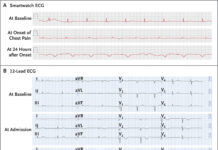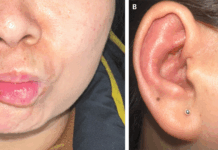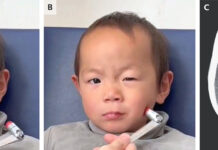The image above is an illustrative representation of Raynaud’s phenomenon, also called Raynaud’s disease or Raynaud’s syndrome. It essentially affects the blood vessels of the fingers, toes, nose, earlobes or lips, causing reversible discolouration (pallor, hyperemia or cyanosis), due to vasospastic effects on the arterioles, leading to ischemia of the tissue. In other words, vessels of the extremities become oversensitive to cold, stress or emotional disturbances.
Raynaud’s phenomenon occurring with other diseases (most commonly with systemic sclerosis and mixed connective tissue disorder) is called secondary Raynaud’s phenomenon, whereas on its own its called primary Raynaud’s phenomenon or Raynaud’s disease, latter being more common than the former and usually affects women between their second to fourth decade of lives. The causes of both remain unknown. Though possible causes of secondary Raynaud’s phenomenon can be: Thyroid disorders, vascular diseases, carpal tunnel syndrome and some drugs like chemotherapeutic agents, beta-blockers etc.
Do people with Raynaud’s react differently to cold than normal?
Normally, to counteract cold environment and to maintain the core body temperature, our body redistributes the blood circulation i.e. redirecting blood from skin to deeper body structure. This phenomenon is exaggerated in patients with Raynaud’s phenomenon, as their vessels go a step ahead and constrict the vessels supplying the fingers, toes, etc. This vasospasticity is the reason behind what we can see in the picture.


Source: https://emedicine.medscape.com/article/331197-treatment#d12
What are the Signs & Symptoms
– Pallor, Rubor or cyanosis
– Pain
– Tingling
– Numbness
– Rarely necrosis
– Look for other signs and symptoms which may hint towards a secondary Raynaud’s for example arthritis, malar rash or nephritis hinting in favour of systemic lupus erythematosus.
Diagnosis
Usually, it is diagnosed on clinical grounds, but if further evaluation is required then a thorough history and examination is a must. Few tests can be performed to eliminate association with other diseases such as CBC, serum glucose, thyroid-stimulating hormone, erythrocyte sedimentation rate, Antinuclear antibody test (ANA), rheumatoid factor, complement levels, etc. If imaging studies are opted for, then Thermography, Isotope studies, Arteriography, Nailfold capillaroscopy (abnormal results only in secondary Raynaud’s) are the options.
How to manage?
Patient education is the key to a fruitful treatment. Since this disease is more about managing than curing, therefore the patient himself is the main player. Primary Raynaud requires lifestyle modifications, including the knowledge of the aggravating factors and how to avoid those. Also, wearing protective clothing like gloves is essential. If drug therapy is required then oral calcium channel blocker is the drug of choice. Topical nitroglycerine has also shown benefits. Managing secondary Raynaud phenomenon revolves around addressing the underlying disease or cause. If the underlying mechanism of disease is autoimmune, such patients, unfortunately, don’t respond well to drug therapies. Accompanied infections like Hepatitis B or C need to be managed too. Having said that, measure for primary Raynaud’s should also be applied to the secondary form. Drugs including calcium channel blockers and prostacyclin analogues have shown promising effects.
- References
- https://emedicine.medscape.com/article/331197-overview
- https://my.clevelandclinic.org/health/diseases/9849-raynauds-phenomenon/diagnosis-and-tests
- https://www.elsevier.es/en-revista-revista-colombiana-reumatologia-english-edition–474-articulo-raynaud39s-phenomenon-associated-with-nitric-S2444440517300249




